 Five panelists for a freshman Orientation presentation found themselves crowded around a smartphone in a compact wing of a stuffy auditorium. The mental health counselor, enrollment advisor, disability services specialist, assistant dean and technology coordinator weren’t reviewing notes or checking email.
Five panelists for a freshman Orientation presentation found themselves crowded around a smartphone in a compact wing of a stuffy auditorium. The mental health counselor, enrollment advisor, disability services specialist, assistant dean and technology coordinator weren’t reviewing notes or checking email.
They were watching soccer.
With Germany’s 1-0 win over Argentina on Sunday, the World Cup has come to a close, and one of the most united sports experiences I can remember concluded.
No, I wasn’t in Brazil. I was in Massachusetts the entire time. But for one of the first times in my sports fan life, most of the people in my life were all invested in the same event. We may not have all been cheering for the same team, but we were all concerned with the same event.
Unlike the Olympics, it was a lone sport we were focused on: soccer. Games weren’t tape delayed or live in the middle of the night. There was one sport to pay attention to, and not several to divide our time amongst. That lone sport was one that almost every single person has played – either in our yards, in gym class or in youth leagues. Soccer is a gateway sport, one of the easiest to learn in the earliest years of our youth. There’s no jumps or judging, and it’s not a sport that you might partake in only certain parts of the country.
Unlike the Super Bowl, we had concrete rooting interests: most of us were rooting for the United States because we reside here, and if we weren’t, we were rooting for the nation of our parents’, grandparents’ or great-grandparents’ birth. Sure, growing up in Western New York around a certain four 1990s Super Bowls, many of us shared a rooting interest in the Buffalo Bills, but then you always had those outliers who didn’t like football or had decided they liked the Dallas Cowboys just to be contrary (but then couldn’t tell you who Emmitt Smith was.)
We could all easily be fans of the World Cup, and so many were. My colleague stood there with his smart phone during the United States’s June 26th 1-0 loss to Germany, and we were all huddled around it in the auditorium wing, swapping out spots as each of us went on stage to give our presentations. These were colleagues I never see at hockey games, ones that had never seemed that concerned with the Super Bowl or World Series parties we had put on for students, ones that never spoke about sports at all. Nevertheless, we were all invested in the outcome of this game.
There were the contrary amongst us (the Dallas Cowboys fans of my earlier example, if you will,) but their tune was increasingly tone-deaf. Calling a sport boring when bars were filled with cheering, groaning and hand-wringing observers? Waving off soccer as the domain of the “rest of the world” when we’ve never been more connected as a planet thanks to shared economies and technology? Building columns and hours of radio based on your dislike of a sport never felt more out-of-touch.
The outliers did have one correct point: even with the World Cup’s mass popularity, soccer has a few miles to go before it gets a vast amount of media coverage and fandom in the United States. But the perfect storm of this World Cup – where watching and following games became a truly “social” social media experience, where kids out on summer break could easily watch a game on a channel most Americans have access to and then run outside and emulate what they saw – propelled that popularity forward significantly.
And what else propelled that forward? That being unified in the following of the World Cup was fun. Standing shoulder to shoulder, watching a smartphone with my colleagues and silently rooting on the United States was fun. Cutting out of work a few minutes early to watch a game at the local bar was fun. Cheering on the same team was fun. I, a part-time sports writer, could enjoy a sporting event alongside someone who rarely follows any sport. It was unifying and enjoyable.
It was what sports are supposed to be.